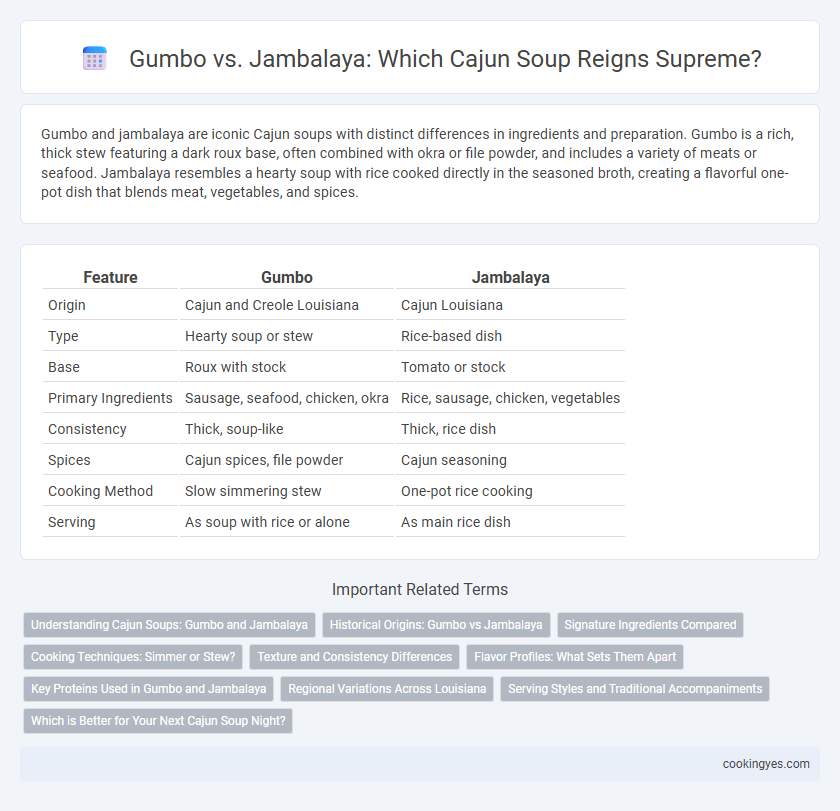Gumbo and jambalaya are iconic Cajun soups with distinct differences in ingredients and preparation. Gumbo is a rich, thick stew featuring a dark roux base, often combined with okra or file powder, and includes a variety of meats or seafood. Jambalaya resembles a hearty soup with rice cooked directly in the seasoned broth, creating a flavorful one-pot dish that blends meat, vegetables, and spices.
Table of Comparison
| Feature | Gumbo | Jambalaya |
|---|---|---|
| Origin | Cajun and Creole Louisiana | Cajun Louisiana |
| Type | Hearty soup or stew | Rice-based dish |
| Base | Roux with stock | Tomato or stock |
| Primary Ingredients | Sausage, seafood, chicken, okra | Rice, sausage, chicken, vegetables |
| Consistency | Thick, soup-like | Thick, rice dish |
| Spices | Cajun spices, file powder | Cajun seasoning |
| Cooking Method | Slow simmering stew | One-pot rice cooking |
| Serving | As soup with rice or alone | As main rice dish |
Understanding Cajun Soups: Gumbo and Jambalaya
Gumbo is a rich, flavorful Cajun stew combining a dark roux base with ingredients like okra, seafood, and smoked sausage, served over rice to create a hearty meal. Jambalaya, in contrast, is a seasoned rice dish cooked with a mix of meats such as chicken, sausage, and shrimp, absorbing bold spices and vegetables in one pot. Both dishes showcase the vibrant spices and culinary traditions of Cajun cuisine, highlighting the region's history and diverse ingredients.
Historical Origins: Gumbo vs Jambalaya
Gumbo originated in Louisiana, blending West African, French, Spanish, and Native American culinary traditions to create a rich stew often thickened with okra or file powder. Jambalaya, also rooted in Louisiana, evolved from Spanish paella, featuring a one-pot rice dish with meat, seafood, and vegetables cooked together. While gumbo emphasizes a roux-based broth and a variety of proteins, jambalaya integrates rice directly into the cooking process, reflecting its unique historical fusion.
Signature Ingredients Compared
Gumbo features a rich roux base combined with okra and file powder, creating a thick, flavorful broth often enriched with seafood, sausage, or chicken. Jambalaya highlights a harmonious blend of smoked sausage, chicken, and shrimp cooked with rice, making it a heartier, drier dish compared to gumbo's soupy consistency. Both dishes showcase signature Cajun seasoning, but gumbo's unique use of okra or file powder distinguishes it from jambalaya's rice-centered preparation.
Cooking Techniques: Simmer or Stew?
Gumbo requires slow simmering to blend the rich flavors of the roux, vegetables, sausage, and seafood or meat, creating a thick, hearty broth characteristic of Cajun soups. Jambalaya involves stewing, where ingredients like rice, meat, and vegetables cook together in one pot, absorbing spices and stock for a less soupy but intensely flavorful dish. Understanding these distinct cooking techniques helps preserve the authenticity and texture unique to each traditional Cajun recipe.
Texture and Consistency Differences
Gumbo features a thick, roux-based broth with a smooth, velvety texture that balances tender meats and crisp vegetables, creating a rich and hearty consistency. Jambalaya offers a drier, more cohesive dish where rice absorbs spices and juices, resulting in a firmer, less soupy texture with each grain distinct yet infused with flavor. The contrast lies in gumbo's soupy, stew-like quality versus jambalaya's more solid, pilaf-style composition, highlighting diverse Cajun approaches to texture and consistency.
Flavor Profiles: What Sets Them Apart
Gumbo features a rich, smoky flavor profile enhanced by the dark roux and the holy trinity of Cajun cooking--onions, bell peppers, and celery--combined with layers of spices and often seafood or sausage. Jambalaya offers a robust, hearty taste with its blend of seasoned rice, tomatoes, and meats like chicken and Andouille sausage, delivering a more textured and savory experience. While gumbo emphasizes a thick, stew-like consistency with deep, complex seasoning, jambalaya is drier and rice-based, providing a more concentrated, spicy kick.
Key Proteins Used in Gumbo and Jambalaya
Gumbo typically features proteins such as chicken, Andouille sausage, and seafood like shrimp or crab, creating a rich, hearty base integral to its slow-cooked, stew-like consistency. Jambalaya combines similar proteins, including chicken, smoked sausage, and a variety of seafood, but incorporates them with rice, resulting in a drier, pilaf-style dish. Both dishes highlight bold, spicy flavors characteristic of Cajun cuisine, with protein choice shaping their distinct textures and tastes.
Regional Variations Across Louisiana
Gumbo and jambalaya represent distinct regional variations of Cajun soups across Louisiana, with gumbo originating primarily in the southern parishes and emphasizing a rich, roux-based broth combined with okra or file powder. Jambalaya, more popular in central Louisiana, features a hearty mix of rice, meats like Andouille sausage, and vegetables cooked together for a robust one-pot meal. Both dishes reflect the cultural fusion of French, African, and Native American influences unique to their respective regions.
Serving Styles and Traditional Accompaniments
Gumbo typically features a rich, roux-based broth served over white rice, allowing the savory mixture of meats, seafood, and vegetables to soak into the rice for a hearty meal. Jambalaya is a one-pot dish where rice is cooked directly with proteins like sausage, chicken, and shrimp, absorbing bold Cajun spices throughout. Traditional accompaniments for gumbo often include file powder and hot sauce, while jambalaya pairs well with crusty French bread and a side of pickled vegetables to balance its robust flavors.
Which is Better for Your Next Cajun Soup Night?
Gumbo offers a rich, hearty broth with a variety of meats, seafood, and the classic "holy trinity" of Cajun vegetables, making it ideal for a flavorful, stew-like experience. Jambalaya combines rice with spiced sausage, chicken, and shrimp, delivering a one-pot, textured dish that's both filling and savory. For your next Cajun soup night, Gumbo's complex, soupy consistency suits those seeking depth and diversity in flavors, while Jambalaya appeals to those wanting a spiced, rice-based meal in a single dish.
Gumbo vs Jambalaya for Cajun soups Infographic

 cookingyes.com
cookingyes.com